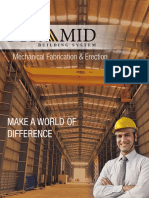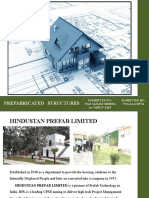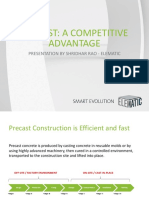Pre-Engineered Buildings
Pre-Engineered Buildings
Uploaded by
Ahmed KhanCopyright:
Available Formats
Pre-Engineered Buildings
Pre-Engineered Buildings
Uploaded by
Ahmed KhanOriginal Description:
Copyright
Available Formats
Share this document
Did you find this document useful?
Is this content inappropriate?
Copyright:
Available Formats
Pre-Engineered Buildings
Pre-Engineered Buildings
Uploaded by
Ahmed KhanCopyright:
Available Formats
A pleasure to do business with
ZAMIL STEEL
Pre-Engineered Buildings
January 1999
PRE-ENGINEERED STEEL BUILDINGS VS. CONVENTIONAL STEEL BUILDINGS
in low-rise building construction
PRE-ENGINEERED STEEL
BUILDINGS (PEBs)
Structure Weight Pre-Engineered Buildings are about 30% lighter
through the efficient use of steel. Primary framing
members are tapered (varying depth) built-up plate
sections with large depths in the areas of highest
stress.
CONVENTIONAL STEEL
BUILDINGS
Primary steel members are selected from standard hot
rolled "I" sections, which are, in many segments of the
members, heavier than what is actually required by
design. Members have constant cross-sections
regardless of varying magnitude of the local stresses
along the member length.
Secondary members are light gage (light weight) cold- Secondary members are selected from standard hot
formed (low labor cost) "Z" or "C" shaped members. rolled "I" and "C" sections, which are heavier.
Design Quick and efficient: since PEBs are mainly formed of Each conventional steel structure is designed from
standard sections and connections, design time is
significantly reduced. Basic designs are used over and
over.
scratch by the Consultant, with fewer design aids
available to the Engineer.
Specialized computer analysis and design programs
optimize material required. Drafting is also
computerized using standard details that minimize
project custom details.
Substantial engineering and detailing is required on
every project. Generalized computer analysis
programs require extensive input/output and design
alterations.
Design, shop detail sketches and erection drawings
are supplied free of charge by the manufacturer.
Approval drawings are usually prepared within 2
weeks.
Extensive consultant time is devoted to design and
drafting, as well as co-ordination and review, often at
a significant expense.
PEB engineers design and detail pre-engineered
buildings almost every day throughout the year
resulting in faster and more efficient designs.
Each project is a separate case, engineers need more
time to develop the designs and details of the unique
structure.
Consultants in-house design and drafting time is
considerably reduced, allowing more time for coordination and review, and increased margins on
design fees.
More complicated design requiring extensive design
and drafting time from Consultants.
Delivery Average 6 to 8 weeks.
Foundations Simple design, easy to construct and light weight.
Erection Simplicity Since the connections of the components are
standard, the learning curve of erection for each
subsequent project is faster.
Average 20 to 26 weeks.
Extensive, heavy foundation required.
The connections are normally complicated and differ
from project to project, resulting in longer learning
curves of erection for new projects.
Periodic free-of-charge erection support at the site is
usually provided by PEB manufacturers.
Erection Cost and Both costs & time of erection are accurately known,
Time based upon extensive experience with similar
buildings.
Typically, they are 20% more expensive than PEB. In
most of the cases, the erection costs and time are not
estimated accurately.
PEBs are often erected by specialized PEB builders
with extensive experience in the erection of similar
buildings, offering very competitive rates. PEB
builders usually have a stock of standard components,
in their camps, enabling them to complete jobs on
time should any shortage or site damage occur to
materials.
The erection process is easy, fast, step by step and
with hardly any requirement for equipment.
Seismic The low-weight flexible frames offer higher resistance
Resistance to seismic forces.
Erection is slow and extensive field labor is required.
Heavy equipment is often needed.
Rigid heavy weight structures do not perform well in
seismic zones.
PRE-ENGINEERED STEEL BUILDINGS VS. CONVENTIONAL STEEL BUILDINGS
in low-rise building construction
PRE-ENGINEERED STEEL
BUILDINGS (PEBs)
Overall Price Price per square meter may be as much as 30%
lower than conventional steel.
Architecture Outstanding architectural design can be achieved at
low cost using standard architectural features and
interface details. Traditional wall and fascia materials,
such as concrete, masonry and wood, can be utilized.
Sourcing and Building is supplied complete with cladding and all
Co-ordination accessories, including erection (if desired) from one
CONVENTIONAL STEEL
BUILDINGS
Rigid heavy weight structures do not perform well in
seismic zones.
Special architectural design and features must be
developed for each project, which often require
research and thus resulting in much higher costs.
Many sources of supply; project management time is
required to co-ordinate suppliers and sub-contractors.
single source
Cost of Change PEB manufacturers often stock a large amount of
Orders basic raw materials that can be flexibly used in many
types of PEB projects.
Substitution of hot rolled sections, that are
infrequently rolled by mills, is expensive and time
consuming.
Change orders are easily accommodated at all stages
of the order fulfillment process. Little or no material is
wasted even if a change order is made after
fabrication starts.
Change orders that are made, after hot rolled sections
are shipped for fabrication, often result in
redundancies to a lot of hot rolled sections, which
ultimately results in more cost to the enduser.
Building Designed to fit the system, with standardized,
Accessories interchangeable parts, including pre-designed flashing
Every project requires special design for accessories
and special sourcing for each item. Flashing and trims
must be uniquely designed and fabricated.
and trims. They are mass produced for economy and
are available with the building. They have been tried
in thousands of existing buildings
Future Expansions All project records are kept in electronic format
indefinitely, making it easy for the owner or designer
to obtain a copy of his building records at any time.
It would be difficult to obtain project records, after a
long period of time. It is required to contact more
than one party, involved in the project, to obtain
accurate information.
Future expansion is simple, easy and cost effective.
One supplier can co-ordinate changes.
Future expansion would be more difficult and, more
likely, costlier.
Responsibility Single source of supply results in total responsibility
by one supplier, including design liability. PEB
manufacturers can be relied upon to service their
buildings long after they are supplied to protect their
reputation.
Performance All components have been specified and designed
Multiple responsibilities can result in questions of who
is responsible when components do not fit properly,
insufficient material is supplied, or materials fail to
perform, particularly at the supplier/contractor
interface. The consultant carries total design liability.
specifically to act together as a system, for maximum
efficiency, precise fit, and peak performance in the
field.
Components are custom designed for a specific
application on a specific job. Design and detailing
errors are possible when assembling the diverse
components into unique buildings.
Experience with similar buildings, in actual field
conditions worldwide, has resulted in design
improvements over time, which allow dependable
prediction of performance.
Each building design is unique, so prediction of how
components will perform together is uncertain.
Materials which have performed well in some climates
may not do so in other environments.
Global Experience Zamil Steel is a global supplier of pre-engineered
Normally, suppliers of conventional steel are oriented
to their local markets with experience in local climatic
conditions only.
buildings to over 50 countries. The company has
acquired vast experience in the performance of PEBs
in different climatic conditions.
Make ZAMIL STEEL your Global Partner.
THE PRE-ENGINEERED BUILDING CONCEPT
The primary framing system
In conventional steel buildings, mill-produced
hot rolled sections (beams and columns) are
used. The size of each member is selected on the
basis of the maximum internal stress in the
member.
Since a hot rolled section has a constant depth,
many parts of the member (represented by the
shaded area), in areas of low internal stresses, are
in excess of design requirements.
Frames of pre-engineered buildings are made
from an extensive inventory of standard plates
stocked by the PEB manufacturer. PEB frames
are normally tapered and often have flanges and
webs of vaiable thicknesses along the individual
members.
The frame geomentry matches the shape of the
internal stress diagram thus minimizing material
waste and reducing the total weight of the structure.
The secondary framing system
Z shaped roof purlins and wall girts are used
for the secondary framing. They are lighter than
the conventional hot-rolled C shaped sections
in conventional steel buildings.
Nesting of the Z shaped members at the frames
allows them to act as continuous members along
the length of the building. This doubles the
strength capacity of the Z shaped members at
the laps where the maximum internal stresses
normally occur.
Saudi Arabia
PO Box 877 Dammam 31421 Phone (966 3) 857 1840 Fax (966 3) 857 1291
Egypt
PO Box 11 Main Post Office 6th of Oct. City Phone (20 11) 341 250 Fax (20 11) 341 247 E-Mail EgyptMarketing@ZamilSteel.com
Vietnam
Noi Bai Ind. Zone Quang Tien Village Phone (84 4) 885 0800 Fax (84 4) 885 0801
www.zamilsteel.com
E-Mail SaudiMarketing@ZamilSteel.com
E-Mail VietnamMarketing@ZamilSteel.com
You might also like
- Pebs ManualDocument59 pagesPebs ManualThi Pham100% (6)
- Seminar On " ": Pre Engineered BuildingsDocument27 pagesSeminar On " ": Pre Engineered BuildingsPrasad NbNo ratings yet
- Name of System - LGSF With Fiber Cement Board On Both Sides Using Glass Wool InsulationDocument7 pagesName of System - LGSF With Fiber Cement Board On Both Sides Using Glass Wool InsulationNishan GajurelNo ratings yet
- Pre-Engineered Building - Wikipedia PDFDocument13 pagesPre-Engineered Building - Wikipedia PDFshubham kothawadeNo ratings yet
- Report On Prefacbricated BuildingsDocument38 pagesReport On Prefacbricated BuildingsParamesh KingNo ratings yet
- Rigid Global Buildings Product ManualDocument269 pagesRigid Global Buildings Product ManualSitaramgv VenkataNo ratings yet
- Pre Fab Technology For BuildingsDocument74 pagesPre Fab Technology For Buildingsvasantharaja rajasekarNo ratings yet
- Arch 220 - Steel Frame ConstructionDocument9 pagesArch 220 - Steel Frame ConstructionSheikh Mizanur Rahman100% (1)
- Cold Formed Steel Joints and Structures - A ReviewDocument14 pagesCold Formed Steel Joints and Structures - A ReviewGabriel MacedoNo ratings yet
- Pre Engineered BuildingDocument8 pagesPre Engineered Buildingkarim hassanNo ratings yet
- Design of Pre-Engineered BuildingDocument8 pagesDesign of Pre-Engineered BuildingBhanu Pratap ReddyNo ratings yet
- Space FramesDocument27 pagesSpace FramesNajib KiwanNo ratings yet
- Intelligent BuildingDocument15 pagesIntelligent Buildingkriti_328No ratings yet
- Pre-Engineered Building Solutions - FUXIN Steel Buildings Co., Ltd. 2015Document28 pagesPre-Engineered Building Solutions - FUXIN Steel Buildings Co., Ltd. 2015vannethny100% (2)
- PEBDocument44 pagesPEBChaitali Thakur100% (1)
- Light Gauge Steel Profiles Case StudyDocument2 pagesLight Gauge Steel Profiles Case StudyDeepum Hallooman100% (1)
- Concrete Panel WallingDocument30 pagesConcrete Panel WallingkjdaraNo ratings yet
- Types of Steel DoorDocument24 pagesTypes of Steel Doorkela vinesNo ratings yet
- GreenCurve Roofing Systems Exporter From ChennaiDocument8 pagesGreenCurve Roofing Systems Exporter From ChennaiJustin MusopoleNo ratings yet
- Two Way Joist Concrete Waffle Slab Floor Design DetailingDocument86 pagesTwo Way Joist Concrete Waffle Slab Floor Design DetailingHung NguyentheNo ratings yet
- PEB BuildingsDocument8 pagesPEB BuildingsPraveen Varma VNo ratings yet
- For Printing Out - ZS-Vietnam - PEB-System-Benefits - Tech-Present - 08-2016 PDFDocument66 pagesFor Printing Out - ZS-Vietnam - PEB-System-Benefits - Tech-Present - 08-2016 PDFKimChhoungChengNo ratings yet
- Composite StructureDocument68 pagesComposite Structurepranavchopra18No ratings yet
- Ankit Mukati 16523004 Pre Engineered BuildingDocument33 pagesAnkit Mukati 16523004 Pre Engineered BuildingAnkit PatidarNo ratings yet
- Prefabricated Structures PDFDocument51 pagesPrefabricated Structures PDFAlex Christopher64% (14)
- PCI - Designer's Notebook, Radiused Precast ConcreteDocument7 pagesPCI - Designer's Notebook, Radiused Precast ConcreteAlexander Arnez AntezanaNo ratings yet
- Light Gauge Steel 1Document15 pagesLight Gauge Steel 1Muhammad UmarNo ratings yet
- Rhino Pre-Engineered Buildings (PVT.) LTD.: Primary Frame Is I Section That Is RAFTER & COLUM (Pillars & Beams)Document6 pagesRhino Pre-Engineered Buildings (PVT.) LTD.: Primary Frame Is I Section That Is RAFTER & COLUM (Pillars & Beams)Haris MustafaNo ratings yet
- Pre Engineered BuildingDocument21 pagesPre Engineered BuildingJamaica Mae AndayaNo ratings yet
- Specs - Zamil SteelDocument12 pagesSpecs - Zamil SteelKhizer. A.No ratings yet
- Prefabricated Structures: Sumbitted To:-Prof. Sanjay Mehra Ar. Varun Jain Sumbitted By: - Yugal GuptaDocument25 pagesPrefabricated Structures: Sumbitted To:-Prof. Sanjay Mehra Ar. Varun Jain Sumbitted By: - Yugal GuptaSwapnil JainNo ratings yet
- Review On PEB BuildingDocument6 pagesReview On PEB BuildingMilanNo ratings yet
- Pre - Engineered BuildingsDocument19 pagesPre - Engineered BuildingsPratikKhatmodeNo ratings yet
- PEB StructuresDocument36 pagesPEB StructuresDass Dass100% (1)
- SteelDocument21 pagesSteelCyrus RivasNo ratings yet
- Portal Frames Final - 2Document19 pagesPortal Frames Final - 2Ar Vivek KareliaNo ratings yet
- Portal Framed ConstructionDocument12 pagesPortal Framed ConstructionMuhammad KhairuddinNo ratings yet
- Prestressed Concrete Structures: Under The Guidance Of: Prof. & Head Department of Civil EngineeringDocument42 pagesPrestressed Concrete Structures: Under The Guidance Of: Prof. & Head Department of Civil EngineeringPtp AbyNo ratings yet
- Pre-Engineered Metal Buildings The Latest Trend in Building ConstructionDocument6 pagesPre-Engineered Metal Buildings The Latest Trend in Building ConstructionAshish SharmaNo ratings yet
- Precast - A Competetive AdvantageDocument41 pagesPrecast - A Competetive AdvantageSony JsdNo ratings yet
- Ideal Choice Homes Brochure - EmailDocument9 pagesIdeal Choice Homes Brochure - EmailRaman IyerNo ratings yet
- Structural DesignDocument34 pagesStructural Designdave4359No ratings yet
- PEB Article Engineered To SucceedDocument5 pagesPEB Article Engineered To SucceedBennoDsouzaNo ratings yet
- PEB PresentationDocument6 pagesPEB PresentationSachin Shinde100% (1)
- Pre Stressed Concrete StructuresDocument39 pagesPre Stressed Concrete StructuresmUSI100% (2)
- Pre Engineered BuildingDocument93 pagesPre Engineered Buildingdhinesh100% (3)
- Compressed FrametechV20Document16 pagesCompressed FrametechV20Abdul Haris MaulanaNo ratings yet
- Adv & Disadv of Steel As Roof TrussesDocument38 pagesAdv & Disadv of Steel As Roof Trussesmkausmally100% (1)
- Hot Rolled Vs PEBDocument2 pagesHot Rolled Vs PEBKawser HossainNo ratings yet
- Prefabricated StructuresDocument81 pagesPrefabricated StructuresrajeshNo ratings yet
- PEB Vs Conventional Steel BuildingsDocument3 pagesPEB Vs Conventional Steel BuildingsPacha Khan KhogyaniNo ratings yet
- Pre Engineered Buildings WordDocument14 pagesPre Engineered Buildings WordLalitha TammanaNo ratings yet
- Pre Engineered Building 1Document24 pagesPre Engineered Building 1mymail.enmontallaNo ratings yet
- Buildings: Faqs For Pre EngineeredDocument5 pagesBuildings: Faqs For Pre EngineeredJitendra PNo ratings yet
- Pre Engineered Buildings 410Document8 pagesPre Engineered Buildings 410Vinit KondapureNo ratings yet
- PEBDocument17 pagesPEBTanuj Bhardwaj100% (1)
- Pre Engineered Buildings 410 PDFDocument7 pagesPre Engineered Buildings 410 PDFDrGanesh KameNo ratings yet
- Report Word FileDocument10 pagesReport Word FileMaricar GaculaNo ratings yet
- Bhanu PEBDocument27 pagesBhanu PEBBhanuprakash KumbarNo ratings yet
- Convetional vs PebsDocument7 pagesConvetional vs Pebsopomprakash4No ratings yet
- Pre-Engineered BuildingsDocument10 pagesPre-Engineered BuildingsAhmed Khan100% (4)
- Peb Brochure GreekDocument36 pagesPeb Brochure GreekAhmed KhanNo ratings yet
- Peb BrochureDocument36 pagesPeb BrochureAhmed KhanNo ratings yet
- Panel ChartDocument4 pagesPanel ChartAhmed KhanNo ratings yet































































